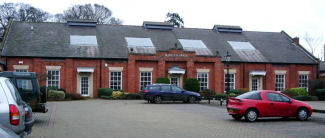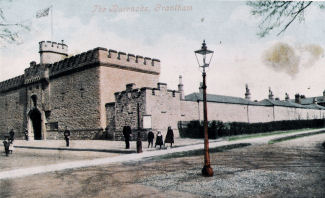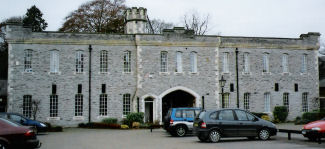Grantham
Sandon road
Wharf road
Wharf road
A Squadron Lincolnshire Yeomanry
B Company, 4th Battalion Lincolnshire Regiment Territorial Force
Sandon Road Barracks:
‘The barracks for the 4th Special Reserve Battalion Lincolnshire Regiment [originally the Royal South Lincolnshire Militia] were erected here when Grantham became their headquarters; they are now occupied by the A Squadron Lincolnshire Yeomanry and B Company, 4th Battalion Lincolnshire Regiment Territorial Force.
The building is of blue stone, in a castellated style, and consists of two quadrangles, the first of which was erected in 1858, at a cost of £3,640; over the gateway is a bandroom; in the centre is the parade ground; a large drill hall was erected in 1911; at the sides are quarters for the permanent staff and stabling; the second court was added in 1872, and includes a reading room; a small field adjoining is used for drill purposes.’ (Kelly, 1913)
There was also an armoury for 1000 rifles, a guard room, three cells for prisoners and stores. According to Pevsner, this building is ‘of 1858 and 1872. Perhaps by Goddard.’ It is ‘castellated and very forbidding. Inside, an impressive courtyard’.
A long narrow rifle range ran the length of the drill hall on the far side to the courtyard. Men also practised their rifle skills in allotments to the rear of the drill hall premises. The rifle range remains, used as a store room by the current occupier, though there is no evidence of its former use.
During the Great War, the drill hall was loaned for use as an Auxiliary Military Hospital between 19th November 1914 and 28 February 1919. It contained 60 beds and 1232 patients were treated there. Photographs exist showing the room decorated for Christmas, 1918, with flags, floral displays and paper chains. Injured servicemen have gathered round a billiard table and a card table, attended by nurses ans doctors.
A brass plaque placed by the British Red Cross Society on an interior wall commemorates the staff of VAD Lincoln.
Members of the local community recall the drill hall in use for social occasions, such as pop concerts. Apparently Tom Jones, Screaming Lord Sutch and The Scaffold have all performed there. It was also used by the local school for sports such as badminton.
The main building now houses offices, but there is a large function room on an upper floor. In the entrance archway, the rack provided for soldiers to deposit their rifles is still there.
The drill hall itself is now a listed building, used by Marilyn Swain Auctions. It has some modern interior partitions, but its roof trusses and window lights are exposed. The original wooden parquet floor remains. The building as a whole is well cared for. Adjacent buildings forming the sides of the quadrangle are in use as commercial offices.
Many thanks to John Munro of Marilyn Swain Auctions for showing me around the drill hall, taking the overview photographs from the gallery, sharing memories and loaning me photographs of its conversion. (GMR, January 2006)
We have been able to assemble a considerable amount of information concerning this Drill Hall, which we hope to be able upload to the site in the not too distant future.
B Company, 4th Battalion Lincolnshire Regiment Territorial Force
‘The barracks for the 4th Special Reserve Battalion Lincolnshire Regiment [originally the Royal South Lincolnshire Militia] were erected here when Grantham became their headquarters; they are now occupied by the A Squadron Lincolnshire Yeomanry and B Company, 4th Battalion Lincolnshire Regiment Territorial Force.
The building is of blue stone, in a castellated style, and consists of two quadrangles, the first of which was erected in 1858, at a cost of £3,640; over the gateway is a bandroom; in the centre is the parade ground; a large drill hall was erected in 1911; at the sides are quarters for the permanent staff and stabling; the second court was added in 1872, and includes a reading room; a small field adjoining is used for drill purposes.’ (Kelly, 1913)
There was also an armoury for 1000 rifles, a guard room, three cells for prisoners and stores. According to Pevsner, this building is ‘of 1858 and 1872. Perhaps by Goddard.’ It is ‘castellated and very forbidding. Inside, an impressive courtyard’.
A long narrow rifle range ran the length of the drill hall on the far side to the courtyard. Men also practised their rifle skills in allotments to the rear of the drill hall premises. The rifle range remains, used as a store room by the current occupier, though there is no evidence of its former use.
During the Great War, the drill hall was loaned for use as an Auxiliary Military Hospital between 19th November 1914 and 28 February 1919. It contained 60 beds and 1232 patients were treated there. Photographs exist showing the room decorated for Christmas, 1918, with flags, floral displays and paper chains. Injured servicemen have gathered round a billiard table and a card table, attended by nurses ans doctors.
A brass plaque placed by the British Red Cross Society on an interior wall commemorates the staff of VAD Lincoln.
Members of the local community recall the drill hall in use for social occasions, such as pop concerts. Apparently Tom Jones, Screaming Lord Sutch and The Scaffold have all performed there. It was also used by the local school for sports such as badminton.
The main building now houses offices, but there is a large function room on an upper floor. In the entrance archway, the rack provided for soldiers to deposit their rifles is still there.
The drill hall itself is now a listed building, used by Marilyn Swain Auctions. It has some modern interior partitions, but its roof trusses and window lights are exposed. The original wooden parquet floor remains. The building as a whole is well cared for. Adjacent buildings forming the sides of the quadrangle are in use as commercial offices.
Many thanks to John Munro of Marilyn Swain Auctions for showing me around the drill hall, taking the overview photographs from the gallery, sharing memories and loaning me photographs of its conversion. (GMR, January 2006)
We have been able to assemble a considerable amount of information concerning this Drill Hall, which we hope to be able upload to the site in the not too distant future.
Wharf road
Kelly lists Wharf Road in 1896. A site visit in 2006 found no evidence of military premises on Wharf Road.
Drill hall set within the quadrangle
of the barracks

Old postcard showing the barracks.

The same view in 2006

Drill hall in use as a sale room in
2006

Baracks gatehouse in 2006

Gatehouse in 2006, viewed from quadrangle

Plaque over main gate.

Plaque commemorating use of the Drill
Hall as an Auxiliary Military Hospital during WW1.
© All material is copyright - refer to the
Terms of Use
the first attempt at content
Introduction
About
Anatomy
Drill
 Database
Database
 Memorabilia
Memorabilia
Resources Glossary
Saving Halls Participate Contact What's New? Terms of Use
Drill
 Database
Database Memorabilia
MemorabiliaResources Glossary
Saving Halls Participate Contact What's New? Terms of Use
The Drill Hall Project - Charting a neglected legacy